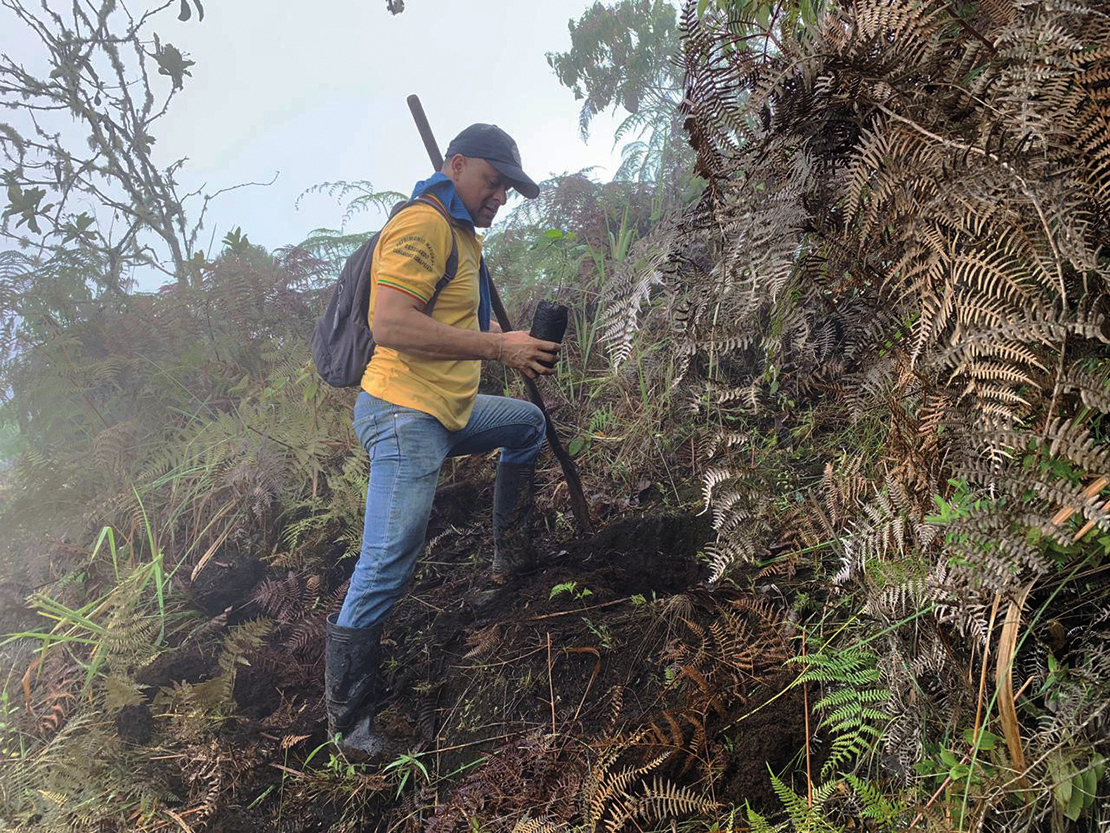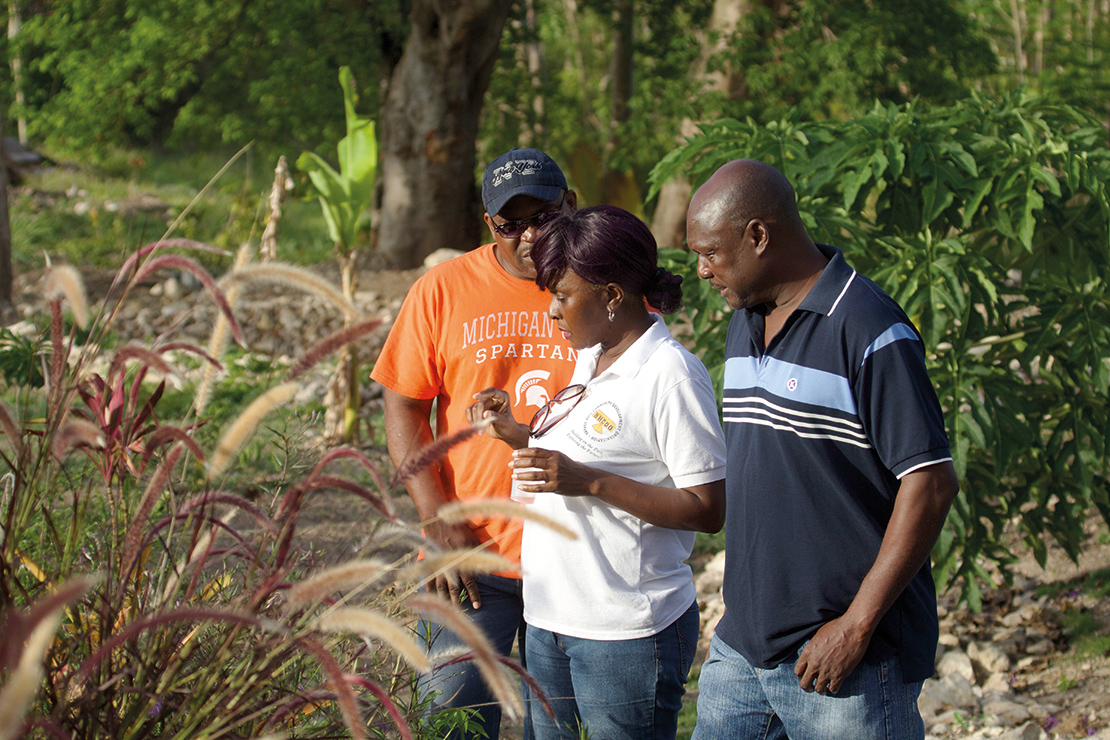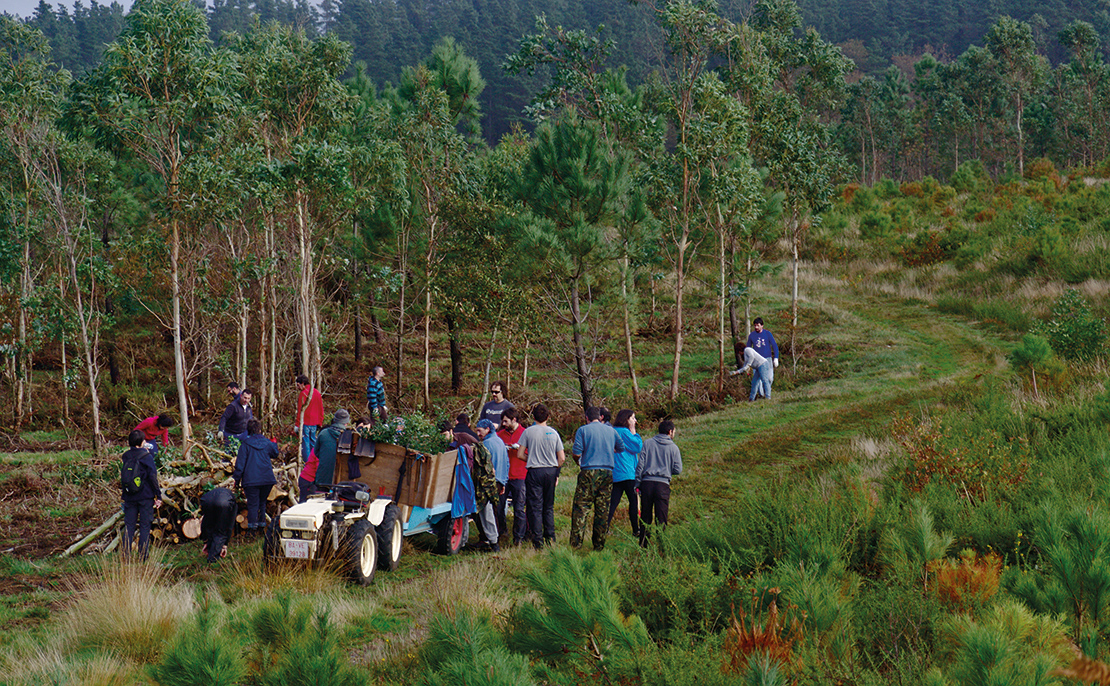
Target 15: Ecosystem restoration and resilience
By 2020, ecosystem resilience and the contribution of biodiversity to carbon stocks has been enhanced, through conservation and restoration, including restoration of at least 15 per cent of degraded ecosystems, thereby contributing to climate change mitigation and adaptation and to combating desertification.
Key messages
- The lands, territories and forests of IPLCs play a vital role in maintaining global carbon stocks, in building ecosystem resilience, and in mitigating and adapting to climate change. Yet they continue to be destroyed and degraded by external interventions.
- IPLCs around the world are working to safeguard and restore their lands, in many cases based on territorial defence and on their traditional knowledge and customary systems of sustainable resource use.
- However, IPLC contributions require much greater recognition and support, and safeguarding measures need to be improved to reduce the impacts of climate change on them and to enable them to upscale their contributions to this target.
Significance of Target 15 for IPLCs
“The Ts’msyen Nation in Northern British Columbia is currently experiencing the effects of climate change and industrial development within our region. Rain patterns are shifting, drought is occurring, ocean temperatures are rising, and industry threatens our way of life and the coastal ecosystem every single day. Support is required from all sectors and government to safeguard our way of life and to help Indigenous peoples and communities mobilize to advance the clean-energy, net-zero-carbon sustainable future that is desperately needed to keep global temperature rises below 1.5°C.”
— Braden Etzerza, Metlakatla First Nation
IPLCs around the world are already experiencing serious effects of climate change, especially those who depend directly on the local environment for their daily needs; this Target 15 is, therefore, of particular concern to them. They are in a good position to contribute to the maintenance and restoration of ecosystems because of their intimate relationship with their lands and resources,1 but harmful subsidies, inappropriate development policies, and continued lack of recognition of customary land rights in many countries means that they are still struggling to maintain forests and ecosystems against large-scale environmental destruction by external actors.2 Indigenous and local knowledge is particularly valuable in ecological restoration and resilience building, but it continues to be undervalued, and is still often neglected in ecological restoration programmes.3 Overall, IPLC contributions and concerns related to Target 15 are still under-recognised, on the ground and in relevant policy forums.4
Contributions and experiences of IPLCs towards Target 15
“I want to be a good ancestor. Indigenous Peoples’ commitments to climate action ensure that we are thinking of the seven generations to come.”5
— Chief Howard Thompson, Haudenosaunee
IPLCs play a crucial role in maintaining the health of ecosystems on their lands, and their actions contribute significantly to global ecosystem resilience. Globally, at least 22 per cent (218 gigatons) of all carbon in tropical and sub-tropical forests (including above- and below-ground) is stored in the collective forestlands of IPLCs, and at least a third of this carbon lies in areas where IPLC land tenure is not formally recognised.6 Community lands commonly experience lower rates of deforestation and forest carbon emissions than other areas, and maintain higher levels of biodiversity, resulting in more resilient landscapes.7 This is due in part to the greater sustainability of customary natural resource management systems based on traditional knowledge, such as those for enriching soil and managing fire8, in comparison to more intensive forms of use.
As fires swept through many parts of Australia at the end of 2019 and beginning of 2020, releasing at least 409,700,000 metric tonnes of carbon dioxide9—more than half of the country’s carbon emissions for the entire year of 2018—various scientists and policymakers called for a revitalisation of Aboriginal fire management systems10 to rebuild ecosystem resilience and avoid similar carbon-releasing disasters in the future. By comparison, the 2019 Brazilian Amazon fires emitted 392,000,000 metric tonnes of carbon dioxide. The Australian bushfires burned more than six million hectares, including national park forests, with smoke reaching as far as Argentina11; the fires devastated many communities and killed an estimated 480 million animals.12
“States must understand that we are the guardians of these territories, of our mother Earth, just as the Amazon forest and other ecosystems in which we live are the hope of the planet. We indigenous women and youths are on the front line defending the rights of indigenous peoples, and now we are facing climate change in our territories and we can provide solutions to this global concern and bring it to all the spaces for political advocacy.”
— Rayanna Maximo Franca, indigenous youth of the Baré people, Indigenous Youth Network of Brazil
Communities are also working actively to restore and reforest degraded environments. Three different examples are featured in this chapter: in Colombia, indigenous peoples are planting trees, cleaning up water sources, and improving waste management (Box 34); in Antigua and Barbuda, the Barnes Hill community has been restoring an abandoned community reservoir and the surrounding environment (Box 35); in Galicia, in Spain (Box 36), a legal mechanism based on traditional systems of communal land tenure has enabled the Froxán community and others to regain control of their lands and work to restore the degraded environment.

Héctor Jaime Vinasco taking part in community reforestation efforts. Credit: RCMLP.
Box 34: Héctor Jaime Vinasco, Governing Council of the Resguardo Cañamomo
Case study: Restoring and reforesting the Cañamomo Lomaprieta Indigenous Resguardo, Colombia
The Cañamomo Lomaprieta Indigenous Resguardo13 in Colombia was created by a royal warrant issued by Carlos I of Spain in 1540. It covers 4,837 hectares and involves 32 communities. The history of Cañamomo Lomaprieta has been concerned largely with territorial defence; its rich gold deposits motivated the conquistadores to found villages within the indigenous territory, and it became a centre for slavery. The indigenous inhabitants were exploited almost to the point of extermination.
— Read the full case study

Sharing information on plants near the Barnes Hill community reservoir, Antigua and Barbuda. Credit: Timothy Payne.
Box 35: Leonard Philip, Barnes Hill Community Development Organization
Case study: Addressing drought through revival of a historic reservoir: Barnes Hill Community, Antigua and Barbuda
The people of Barnes Hill community are working together to restore their community reservoir, which was built in the 1890s to provide the village with fresh water in times of drought but had fallen into disuse and disrepair. Water shortages during a recent four-year drought led to serious impacts, not only on plants and animals but also on human health and sanitation. The village nurse documented illnesses at the clinic that were directly related to a lack of water for basic needs. The drought and the need for water brought the people together to seek solutions, and in 2015 this led to the formation of the Barnes Hill Community Development Organization.
— Read the full case study
Box 36: Joám Evans Pim, Froxán Common Lands Community
Restoring the woodland at Froxán Common Lands Community, Spain. Credit: Verdegaia.

Case study: Climate change adaptation: Restoring community common lands in Galicia, Spain
Monte veciñal en man común (community common lands) is a legal mechanism in Galicia, Spain, recognising communal land tenure. It is based on traditional customary systems that recognised community rights and obligations under the ancient feudal tenure system. During the mid-20th century, these systems were undermined in favour of commercial forestry and mining, resulting in severe environmental degradation and restricted community access to their lands. The legal designation has allowed many communities to regain control of their lands and start to restore the degraded environment since the 1970s.
— Read the full case study
Opportunities and recommended actions
- IPLCs should continue to implement and strengthen community-based approaches and activities for socio-ecological resilience and restoration.
- Governments and relevant actors should increase recognition and support for local community actions for ecosystem protection, restoration and resilience-building, including agroforestry, agroecology and traditional fire management systems.
- Governments and relevant actors should fully recognise the significance and role of indigenous and local knowledge in ecological restoration.
- Governments and donor agencies should upscale climate funds for IPLC actions related to resilience, restoration and carbon storage, and enhance mechanisms to make funds easily available, on an equitable basis.
Key resources
- Rights and Resources Initiative et al. (2018) ‘A global baseline of carbon storage in collective lands’. Rights and Resources Initiative: Washington D.C. Available at: https://rightsandresources.org/en/publication/globalcarbonbaseline2018/
- Indigenous Peoples’ Major Group for Sustainable Development (2019) Inclusion, equality, and empowerment to achieve sustainable development: Realities of indigenous peoples. Baguio City and San Francisco: Indigenous Peoples’ Major Group for Sustainable Development. Available at: https://www.indigenouspeoples-sdg.org/index.php/english/all-resources/ipmg-position-papers-and-publications/ipmg-reports/global-reports/124-inclusion-equality-and-empowerment-to-achieve-sustainable-development-realities-of-indigenous-peoples/file
- Uprety, Y., Asselin, H., Bergeron, Y., Doyon, F. and Boucher, J-F. (2012) ‘Contribution of traditional knowledge to ecological restoration: practices and applications’, Ecoscience 19, pp. 225–37.
- Wehi, P.M. and Lord, J.M. (2017) ‘Importance of including cultural practices in ecological restoration’, Conservation Biology 31(5), pp. 1109–18.
References
- Reyes-García, V., Fernández-Llamazares, Á., McElwee, P., Molnár, Z., Öllerer, K., Wilson, S. J., Brondizio, E. S. (2018) ‘The contributions of Indigenous Peoples and local communities to ecological restoration’, Restoration Ecology 27(1), pp. 3–8.
- Indigenous Peoples’ Major Group for Sustainable Development (2019) Inclusion, equality, and empowerment to achieve sustainable development: Realities of Indigenous Peoples. Baguio City and San Francisco: Indigenous Peoples’ Major Group for Sustainable Development. Available at: https://www.indigenouspeoples-sdg.org/index.php/english/all-resources/ipmg-position-papers-and-publications/ipmg-reports/global-reports/124-inclusion-equality-and-empowerment-to-achieve-sustainable-development-realities-of-indigenous-peoples/file
- Wehi, P. M. and Lord, J. M. (2017) ‘Importance of including cultural practices in ecological restoration’, Conservation Biology 31(5), pp. 1109–18.
—
Uprety, Y., Asselin, H., Bergeron, Y., Doyon, F. and Boucher, J-F (2012) ‘Contribution of traditional knowledge to ecological restoration: practices and applications’, Ecoscience 19, pp. 225–37. - Reyes-García, V., Fernández-Llamazares, Á., McElwee, P., Molnár, Z., Öllerer, K., Wilson, S. J., Brondizio, E. S. (2018) ‘The contributions of Indigenous Peoples and local communities to ecological restoration’, Restoration Ecology 27(1), pp. 3–8.
- International Work Group for Indigenous Affairs (2019) ‘Indigenous Peoples commit to climate action at UNSG Climate Action Summit’. Available at: https://www.iwgia.org/en/focus/climate-action/3469-indigenous-peoples-commit-to-climate-action
- Rights and Resources Initiative et al. (2018) A global baseline of carbon storage in collective lands. Rights and Resources Initiative: Washington D.C. Available at: https://rightsandresources.org/en/publication/globalcarbonbaseline2018/
- Masson-Delmotte, V., Zhai, P., Pörtner, H., Roberts, D., Skea, J. Shukla, P. R., Pirani, A. et al. (2019) Global Warming of 1.5°C: An IPCC Special Report on the Impacts of Global Warming of 1.5°C above Pre-Industrial Levels and Related Global Greenhouse Gas Emission Pathways, in the Context of Strengthening the Global Response to the Threat of Climate Change. Bonn: UNFCCC.
- Butchart, S. H. M., Miloslavich, P., Reyers, B. and Subramanian, S. M. (Draft) ‘Chapter 3. Assessing Progress towards Meeting Major International Objectives Related to Nature and Nature’s Contributions to People’, in IPBES Global Assessment on Biodiversity and Ecosystem Services. Bonn: IPBES.
- Lombrana, L.M., Warren, H., Rathi, A. (2019) ‘Measuring the carbon-dioxide cost of last year’s worldwide wildfires’. Bloomberg. Available at: https://www.bloomberg.com/graphics/2020-fire-emissions/
- Australian Broadcasting Corporation (2020) ‘Fighting fire with fire’. Australian Story. ABC TV. Sydney: Australian Broadcasting Corporation. Available at: https://www.abc.net.au/austory/fighting-fire-with-fire/12134242
- Lombrana, L.M., Warren, H., Rathi, A. (2019) ‘Measuring the carbon-dioxide cost of last year’s worldwide wildfires’. Bloomberg. Available at: https://www.bloomberg.com/graphics/2020-fire-emissions/
- Dickman, C. (2020) ‘A statement about the 480 million animals killed in NSW bushfires since September’. Sydney: The University of Sydney. Available at: https://www.sydney.edu.au/news-opinion/news/2020/01/03/a-statement-about-the-480-million-animals-killed-in-nsw-bushfire.html
- Resguardos indigenas are “the collective property of the indigenous communities for which they are established and … are inalienable, imprescriptible and unseizable.” Source: Colombian Ministry of the Interior (2013) Resguardo Indígena. Available at: https://www.mininterior.gov.co/content/resguardo-indigena


